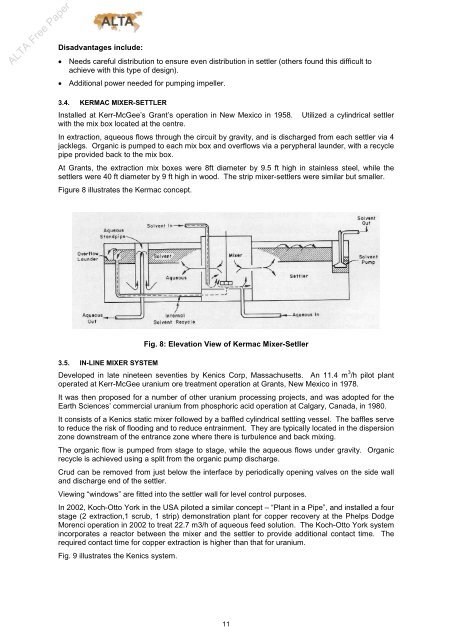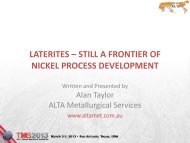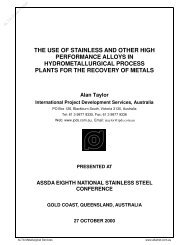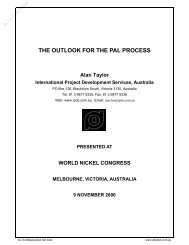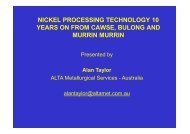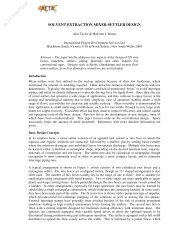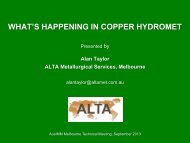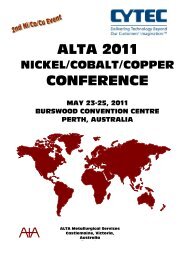review of mixer-settler types and other possible contactors for ...
review of mixer-settler types and other possible contactors for ...
review of mixer-settler types and other possible contactors for ...
You also want an ePaper? Increase the reach of your titles
YUMPU automatically turns print PDFs into web optimized ePapers that Google loves.
ALTA Free Paper<br />
Disadvantages include:<br />
<br />
<br />
Needs careful distribution to ensure even distribution in <strong>settler</strong> (<strong>other</strong>s found this difficult to<br />
achieve with this type <strong>of</strong> design).<br />
Additional power needed <strong>for</strong> pumping impeller.<br />
3.4. KERMAC MIXER-SETTLER<br />
Installed at Kerr-McGee’s Grant’s operation in New Mexico in 1958.<br />
with the mix box located at the centre.<br />
Utilized a cylindrical <strong>settler</strong><br />
In extraction, aqueous flows through the circuit by gravity, <strong>and</strong> is discharged from each <strong>settler</strong> via 4<br />
jacklegs. Organic is pumped to each mix box <strong>and</strong> overflows via a perypheral launder, with a recycle<br />
pipe provided back to the mix box.<br />
At Grants, the extraction mix boxes were 8ft diameter by 9.5 ft high in stainless steel, while the<br />
<strong>settler</strong>s were 40 ft diameter by 9 ft high in wood. The strip <strong>mixer</strong>-<strong>settler</strong>s were similar but smaller.<br />
Figure 8 illustrates the Kermac concept.<br />
3.5. IN-LINE MIXER SYSTEM<br />
Fig. 8: Elevation View <strong>of</strong> Kermac Mixer-Setller<br />
Developed in late nineteen seventies by Kenics Corp, Massachusetts. An 11.4 m 3 /h pilot plant<br />
operated at Kerr-McGee uranium ore treatment operation at Grants, New Mexico in 1978.<br />
It was then proposed <strong>for</strong> a number <strong>of</strong> <strong>other</strong> uranium processing projects, <strong>and</strong> was adopted <strong>for</strong> the<br />
Earth Sciences’ commercial uranium from phosphoric acid operation at Calgary, Canada, in 1980.<br />
It consists <strong>of</strong> a Kenics static <strong>mixer</strong> followed by a baffled cylindrical settling vessel. The baffles serve<br />
to reduce the risk <strong>of</strong> flooding <strong>and</strong> to reduce entrainment. They are typically located in the dispersion<br />
zone downstream <strong>of</strong> the entrance zone where there is turbulence <strong>and</strong> back mixing.<br />
The organic flow is pumped from stage to stage, while the aqueous flows under gravity. Organic<br />
recycle is achieved using a split from the organic pump discharge.<br />
Crud can be removed from just below the interface by periodically opening valves on the side wall<br />
<strong>and</strong> discharge end <strong>of</strong> the <strong>settler</strong>.<br />
Viewing “windows” are fitted into the <strong>settler</strong> wall <strong>for</strong> level control purposes.<br />
In 2002, Koch-Otto York in the USA piloted a similar concept – “Plant in a Pipe”, <strong>and</strong> installed a four<br />
stage (2 extraction,1 scrub, 1 strip) demonstration plant <strong>for</strong> copper recovery at the Phelps Dodge<br />
Morenci operation in 2002 to treat 22.7 m3/h <strong>of</strong> aqueous feed solution. The Koch-Otto York system<br />
incorporates a reactor between the <strong>mixer</strong> <strong>and</strong> the <strong>settler</strong> to provide additional contact time. The<br />
required contact time <strong>for</strong> copper extraction is higher than that <strong>for</strong> uranium.<br />
Fig. 9 illustrates the Kenics system.<br />
11


